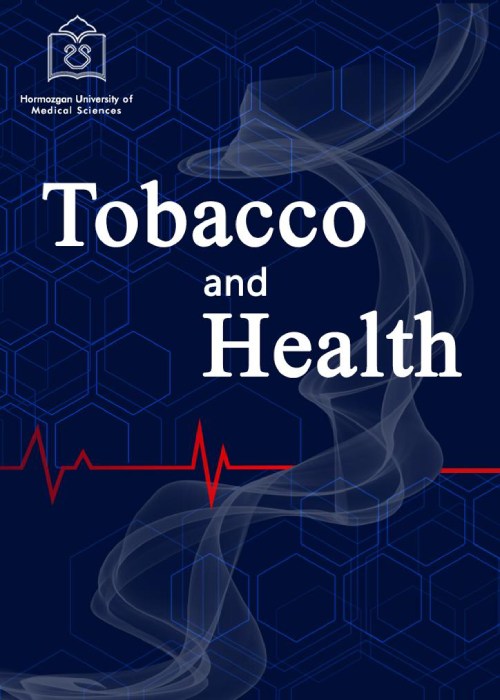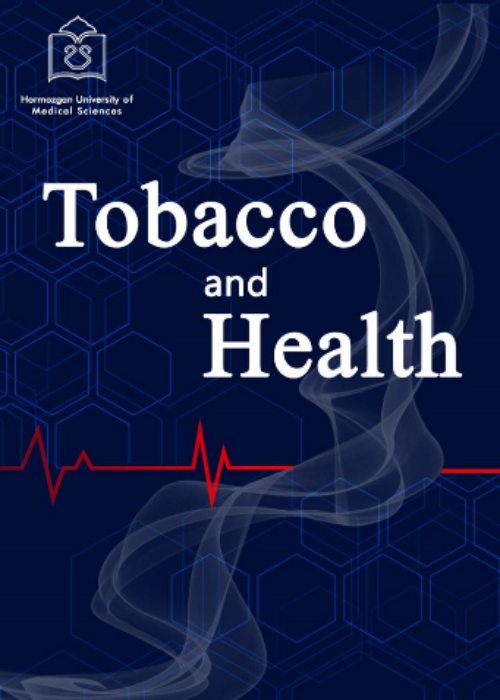فهرست مطالب

Tobacco and Health
Volume:2 Issue: 2, Jun 2023
- تاریخ انتشار: 1402/03/31
- تعداد عناوین: 7
-
Pages 47-53Background
Smoking is the main cause of illness and death worldwide. It is a serious public health problem and a habit that has consequences for the individual’s quality of life (QoL). The aim of the study was to evaluate the QoL of patients undergoing tobacco cessation treatment in a multidisciplinary program in Brazil.
Materials and MethodsThe current retrospective study was performed on patients undergoing tobacco cessation treatment in a multidisciplinary program of the Institute of Science and Technology, São Paulo State University (UNESP), Brazil, São José dos Campos, from March to December 2015. The 36-Item Short Form Survey (SF-36), Fantastic Lifestyle, Self-Reporting (SRQ-20), Medical Outcomes Study (MOS), and the State Trait Anxiety Inventory Questionnaires (STAI s/t) were administered to 71 participants who were selected according to the inclusion criteria.
ResultsThe smoking habit affected the QoL of the user, especially in the physical functioning, social aspect, vitality, and mental health domains of the SF-36 survey and the Fantastic Lifestyle Questionnaire. It also influenced depression and the social support of the patient as we could see by the application of the SRQ-20 questionnaire and by the MOS questionnaire, respectively.
ConclusionWe could see that there is a negative relationship between smoking and QoL and that smoking influences depression and the social support of the user. These findings highlight that effective tobacco cessation interventions are crucial. Healthcare providers and policymakers must prioritize tobacco control to reduce the burden of tobacco-related diseases and improve community well-being.
Keywords: Tobacco use cessation, Quality of life, Tobacco use disorder, Indicators of quality of life, Smokers -
Pages 54-59Background
The most important step in controlling smoking is to know the factors related to smoking. This study was conducted to determine the prevalence of smoking and factors related to smoking among students of Shahid Sadoughi University of Medical Sciences.
Materials and MethodsThis cross-sectional study was carried out on 250 students of Yazd University of Medical Sciences. In the present study, subjects were selected by simple random sampling. Data were collected through a valid questionnaire. Statistical analysis was performed using chi-square test, descriptive statistics, and logistic regression in SPSS version 24.0 at a significance level of P < 0.05.
ResultsIn the present study, the prevalence of smoking and history of the consumption of narcotics was determined to be 19.2% and 69.2%, respectively. The most important factor related to smoking was unemployment (31.25%) but the main motivation for smoking was entertainment (31.25%). According to the results of logistic regression analysis, it can be said that male gender (OR = 9.25), being non-native (OR = 13.01), living in a rented house (OR = 15.96), Kurdish ethnicity (OR = 6.94), having a smoking father (OR = 4.42), and having a smoking mother (OR = 25.5) were the most important risk factors for smoking among students.
ConclusionGiven the high prevalence of smoking and awareness of factors related to smoking among medical sciences students as messengers of health, providing the amenities and comfort, holding workshops on life skills, and establishing consulting centers are necessary to decrease the social and medical burden of smoking.
Keywords: Smoking, Prevalence, Risk factor, Students, Yazd -
Pages 60-63Background
Cross-sectional studies have shown that smokers have lower mental and physical health status than non-smokers. Smoking also has aggravating effects on workers who were exposed to the harmful factors of the work environment, noise, and asbestos.
Materials and MethodsThe present study is a review and similar to other review studies, it was done by examining the findings and results of other studies. In order to search for related materials, keywords and their synonyms were searched in medical databases and their contents were analyzed and classified into three areas.
ResultsThese areas include “aggravating effects of smoking in workers exposed to noise”, “aggravating effects of smoking in workers exposed to asbestos” and “the effects of smoking on cognitive performance of workers”.
ConclusionThe results of the studies showed that education about the aggravating effects of smoking on occupational diseases, medical examinations of workers, elimination or limitation of asbestos use, and conducting psychological tests can be suggested as suitable solutions that fit the culture and capabilities of the country’s health system.
Keywords: Smoking, Asbestos, Noise, Cognitive function -
Pages 64-69
Hearing loss due to noise is considered one of the most common occupational diseases around the world. Hearing impairment can be caused by a combination of mechanical and metabolic factors. On the other hand, smoking can affect the blood supply to the cochlea due to changes in peripheral vessels. One of the factors that can have an ototoxic effect on the hearing system is the use of tobacco. The objective of this study was to review studies on the relationship between smoking and hearing loss. For this purpose, several studies that had reported different results in the last recent years were reviewed and their results were reported. Databases included Web of Sciences, PubMed/Medline, EMBASE, and Cochrane. The study results showed that the use of tobacco causes hearing loss and a reduction in the hearing threshold, especially at high and speech frequencies. As a result, smoking and noise have a common process for hearing loss. This effect becomes more intense as the intensity of smoking and age increase. The important point is that there are industries that are noisy and the risk of hearing loss in smokers can cause more accidents in industries in addition to imposing an economic burden on society, as well as isolation, social problems, and a reduction in people’s quality of life. Therefore, more emphasis should be placed on the implementation of smoking cessation training plans, especially for workers who work in noisy environments.
Keywords: Tobacco, Deafness, Smoking -
Pages 70-78Background
In spite of great advances in the prevention of bacterial infections, they are still considered the most common reason for mortality worldwide. In accordance with the data from the World Health Organization (WHO), around 15% of pediatric mortality was caused by bacterial infections in 2017. Since cigarette smoke can cause serious damage to organs such as the respiratory system and weakening of the immune system, the aim of the present review study was to investigate the effects of cigarette smoking on various bacterial pneumonia.
MethodsThe present review study was performed on 90 articles obtained through searching in ScienceDirect, Scopus, PubMed, and Google Scholar using keywords such as bacterial pneumonia, Staphylococcus, Streptococcus, Haemophilus, Pseudomonas, Legionella, Mycoplasma, Chlamydia, tuberculosis, and cigarette.
ResultsDifferent results of previous studies indicated that given the detrimental effect of cigarettes on the respiratory and immune system of individuals, cigarette smoking affects the prognosis and outcome of infectious diseases. Disease severity, requiring hospitalization at both general and intensive care units, and mortality rate vary across these patients, thereby challenging the treatment. Thus, the cessation of cigarette smoking may help improve the respiratory system function.
ConclusionGiven contradictions in the results of previous studies, exposure to cigarette smoke affects the respiratory system and increases the severity of bacterial pneumonia.
Keywords: Cigarette, Smoking, Bacterial pneumonia -
Pages 79-82
Environmental tobacco smoke (ETS), similar to firsthand and secondhand smoke, is a complex mixture containing thousands of chemicals, many of which are known as carcinogens. The high combustion temperature of tobacco and the presence of nitrogen in the tobacco can lead to the release of nitrogen oxides (NOx). From the NOx, NO2 irritates the respiratory system and damages cells and mucous membranes of the lungs. The selected databases for this systematic review were Science Direct, Springer, PubMed, and Google Scholar, and the keywords of the search plan included “nitrogen oxide”, “NOX”, “ETS”, “Cigarette smoke”, “Waterpipe smoke”, and “Tobacco smoke”. Finally, 797 articles were found, and after reviewing, 7 articles met our criteria. The results demonstrated that the mean air concentration of tobacco smoke related-NOX was 9.71 ± 11.03 ppm, which was higher than the annual guideline level of free air quality (0.053 ppm). The mean concentration of NOX in cigarette smoke was 329.45 ± 465.43 ppm, and for smoking places, it was higher than for nonsmoking places (17.80 vs. 12.47 ppm). Moreover, for the cigarette smoke, it was higher than for the waterpipe smoke (5.66 vs. 0.16 ppm). In this regard, the cigarette is more suspected to the emission of NOx compared to waterpipe, and tobacco smoking can expose people to high levels of NOx regarding the limited guideline levels. Finally, the concentration of NO in cigarette smoke and air was higher than NO2.
Keywords: Air pollution, Cigarette, Waterpipe, Nitrogen oxides -
Pages 83-87Background
The present research aimed to explore the relationship between tobacco consumption and menopause characteristics in women in southern Iran.
Materials and MethodsThe current cross-sectional study used the basic data of Bandar Kong Cohort in southern Iran. A cross-sectional analysis was conducted on these 867 postmenopausal women in 2016. The data collection instrument was a questionnaire based on a review of the related literature, actual experiences, and the existing instruments utilized in cohort studies in Iran and foreign countries. The chi-square test, independent samples t test, and logistic regression analysis were employed for analyses in SPSS.
ResultsOverall, 867 postmenopausal women were included in the study. Their average age was 57.42 ± 6.34 years. Menopause-smoker women had a lower level of education and body mass index (BMI), and the difference was statistically significant. In the present study, the widows, divorcees, and others used at least one tobacco product such as cigarettes, waterpipe, opium, or alcohol to a greater extent than the married. There was a significant difference between the economic status of postmenopausal women and their tobacco consumption.
ConclusionThe findings of the present study demonstrated no significant relationship between tobacco and menopause. However, there was a significant relationship between the level of education and BMI and smoking in postmenopausal women. Considering the increase in life expectancy in women and the aging of the population in recent years, the number of postmenopausal women has increased in society. Thus, it is necessary to hold training for lifestyle modification for menopausal women.
Keywords: Menopause, Smoking, Tobacco


